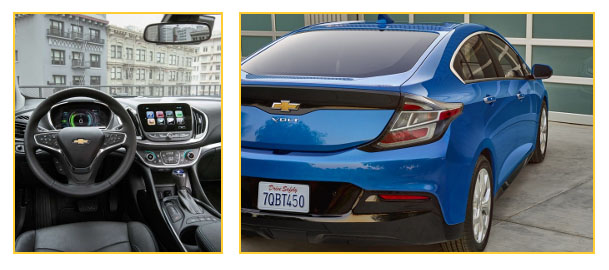Test Drive Notes Library
-
 Pros
Pros
- The perfect electric car for our times.
- It’s a real electric car without the range anxiety. The drivetrain technology really works. You can drive it 50+ miles on batteries alone every day. But then, if you need to keep going, the backup gasoline engine seamlessly kicks in, and you can go another 300 miles on gasoline. So your total range is more than 350 miles. Or, approximately SF to LA.
- Most people who have modest commutes will never use the gasoline engine. They’ll be — for all intents and purposes— driving an electric car. We drove it for a week, and never used anything but electric power. But the great thing is… the backup is always there if you need it.
- On electricity, it gets 106MPGe. Using just the gasoline engine, it gets an extremely respectable 42 MPG.
- Feels more solid and luxurious than the last Prius we drove. While the Prius has a well deserved reputation for quality, the Volt makes the Prius feel tinny by comparison. And the plug-in Prius has less than half the electric range of the Volt. Even though it’s based on the same chassis as the Chevy Cruze, the lower center of gravity and luxury add-ons hide its economy car roots pretty well.
- On our “Premier" trim test car, the interior is hugely improved over the old Volt. While the old Volt had a plasticky, pseudo-futuristic thing going on, this Volt has a pseudo-luxury thing going on. All the surfaces feel like quality materials, from the steering wheel to the seats to the padding on the center armrest.
- Controls are much more straight-forward, with proper knobs for heating, cooling, and audio volume. A reasonably straight-forward touch screen (with a very useful home button) handles the rest, and features Apple’s Car Play. We love the volume controls on the back of the steering wheel — right where your index and middle fingers naturally rest. Everyone should have those.
- Feels solid and handles pretty well. It’s got a low center of gravity, thanks to the batteries. But Chevrolet has tuned the ride for comfort rather than for sporty handling. So on turns, there is definitely some body lean. But on city roads, the Volt is quiet, and absorbs bumps well. The Volt is well insulated and quiet inside.
- Typical of electric vehicles (in our experience), the accelerator pedal starts the car gently. I guess they want to encourage people to be economical. If you really want to move, you have to press into the pedal some. But when you do, it’s got plenty of power. All you need.
- You can get it with all the safety features we feel strongly about, including blind spot monitoring, forward collision alert and automatic emergency braking (low speed only).
- The hatchback (even though it looks like a sedan) makes the Volt a very practical and versatile car.
- Back seat is comfortable for two, though you sit low. Rear seats fold down to increase cargo room.
- Charges easily overnight (approximately 8 hours) with a regular old 120V outlet. About half that time if you get a 220V fast charger.
- Very reasonably priced. Our loaded Volt Premier (navigation, advanced safety equipment, leather, 8-speaker Bose system) listed for just under $40,000. Subtract whatever state or federal tax rebates you get, and it’s a very nice, extremely eco-friendly, versatile car with great drivetrain technology, for a not-ridiculous amount of money.
-
 Cons
Cons
- Can’t see a damn thing out the back. While the Prius came up with a clever slice of extra rear window in the lowest part of the hatchback, Chevy asks you to make do with the slit of rear window you can see out of from the driver’s seat. Don’t expect to see anything. The Volt comes with a rear view camera that’s a pretty good one. Good thing, because you’d be backing into garbage cans every day without it.
- It has the same problem in the three-quarter rear view. Fortunately again, blind spot monitoring can save your bacon. That’s optional, and we’d strongly recommend it. The blind spot warning lights themselves, in the side view mirrors, could stand to be a bit bigger.
- The touch screen’s Apple Play has a few quirks. When we tried to listen to the radio while using Google Maps on an iPhone, the audio would switch to the iPhone whenever a navigation direction was given, and we’d be forced to manually switch the audio system back to the radio. That may not be Chevy’s fault, but early adopters should take note.
- The touch screen is large and easy to read, but it’s been canted back, presumably to add to the feeling of airiness and openness in the cabin. Unfortunately, that makes it a little harder to reach.
Test Drive Notes Library
Get the Car Talk Newsletter
 Pros
Pros Cons
Cons


